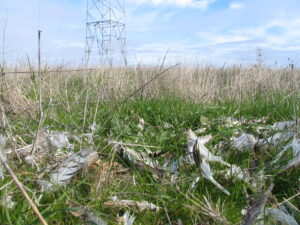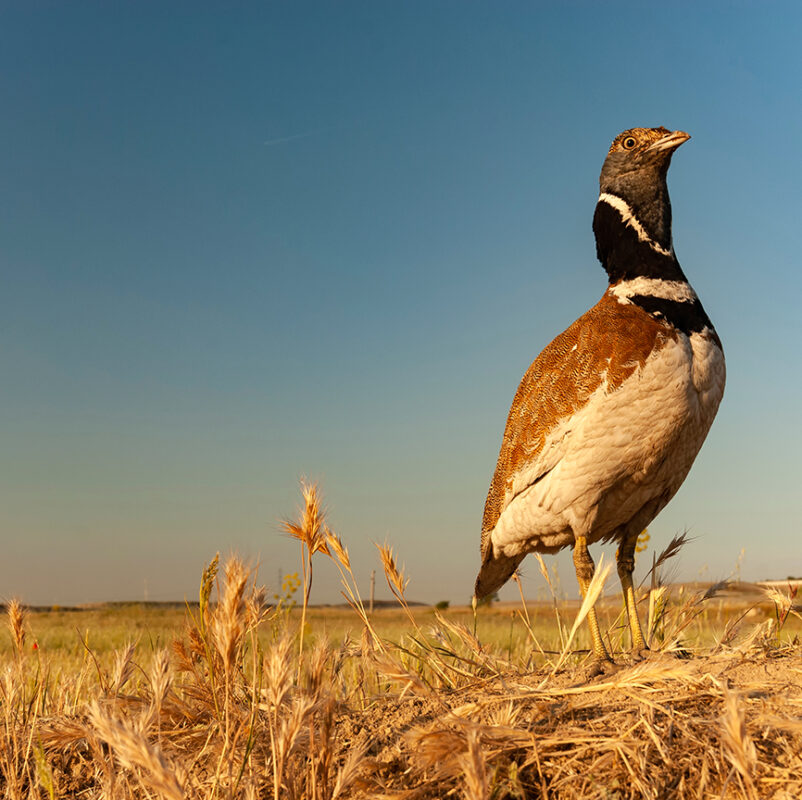A study reveals how changing agricultural practices and increasing the area devoted to fallow can help preserve the populations of this species seriously threatened by human activity
Collaboration between scientists, farmers and managers is decisive to improve the protection of the little bustard, a steppe bird considered endangered at the national level due to human activities. With the reduction of natural habitats, the increase in irrigation and the urbanization of the territory, there is less and less surface area that guarantees the survival of this very vulnerable species. An article published in the journal Biological Conservation reveals how cooperation between different actors is the key to finding answers and avoiding the decline of the increasingly threatened populations of the little bustard.
The new work, which is a pioneering example of adaptive conservation, is signed by the experts Santi Mañosa, from the Faculty of Biology and the Biodiversity Research Institute (IRBio) of the University of Barcelona, and Gerard Bota, from the Group of Conservation Biology of the Forest Science and Technology Center of Catalonia (CTFC).
A steppe bird in danger
 For birds such as the little bustard (Tetrax tetrax), it is increasingly difficult to find suitable habitats due to the shrinking of the steppe landscape and the disappearance of traditional agriculture and livestock farming. The new article confirms that increasing fallow agricultural land – that is, unsown cropland – helps stabilize the little bustard population in Catalonia.
For birds such as the little bustard (Tetrax tetrax), it is increasingly difficult to find suitable habitats due to the shrinking of the steppe landscape and the disappearance of traditional agriculture and livestock farming. The new article confirms that increasing fallow agricultural land – that is, unsown cropland – helps stabilize the little bustard population in Catalonia.
“This strategy acts positively on the little bustard, especially because it increases reproductive success, since it provides the species with everything that has disappeared in dryland agricultural environments as a result of the intensification of agricultural practices,” details Professor Santi Mañosa, from the Department of Evolutionary Biology, Ecology and Environmental Sciences of the UB.
«In spring – he continues – they find food, places for males to make their nuptial stop to attract females, pair, nest and feed the chicks. In summer and autumn, and much of the winter, when the crops are mowed and plowed, the fallows remain the only spaces with some vegetation cover sufficient to provide shelter and food to the flocks of little bustards, which once reproduction is finished becoming gregarious.
However, fallow lands have lost a lot of interest from a productive and agronomic perspective and are in decline throughout the territory. «Between 2009 and 2018, 21% of the fallow area has been lost in
Catalonia according to the latest Report on the State of Nature in Catalonia published in 2020, and steppe bird populations have been reduced by 27% between 2002 and 2019, especially due to the loss of fallow land as one of the main causes,” explains expert Gerard Bota. «The little bustard is one of the most affected and one of the species that has suffered the greatest decline in Catalonia and other areas of Spain in a short time. As a result of this situation, it is currently classified as an “Endangered” species at the Spanish level, at the same level of threat as other emblematic species such as the bearded vulture, the brown bone or the Iberian lynx.
What to do besides promoting fallow land?
The population models generated in this work show that increasing the area dedicated to fallow could stop the species’ dizzying path towards disappearance, “but this measure, although essential, is not enough to recover the population, since that adult mortality – especially in females – is still excessive,” warns Santi Mañosa.
 “It will be essential to implement other conservation measures that have been little worked on to date,” highlights Gerard Bota. «For example, reduce adult mortality of females, mainly that of anthropic origin, which is what we can manage. We know that the little bustard is a species very sensitive to mortality from collisions with power lines due to its relatively reduced forward vision in flight. It would be necessary to identify the main post-breeding and winter aggregation areas and act on the power lines that are installed to reduce the probability of death of the specimens. In the most important breeding and wintering areas, the burying or elimination of some lines should be addressed and, in the rest of the areas, correct marking of lines with anti-collision elements should be carried out.
“It will be essential to implement other conservation measures that have been little worked on to date,” highlights Gerard Bota. «For example, reduce adult mortality of females, mainly that of anthropic origin, which is what we can manage. We know that the little bustard is a species very sensitive to mortality from collisions with power lines due to its relatively reduced forward vision in flight. It would be necessary to identify the main post-breeding and winter aggregation areas and act on the power lines that are installed to reduce the probability of death of the specimens. In the most important breeding and wintering areas, the burying or elimination of some lines should be addressed and, in the rest of the areas, correct marking of lines with anti-collision elements should be carried out.
Generate trust and cooperation between different sectors
In 2009, a total of eight Special Protection Areas for Birds (SPA) were declared in the steppe sectors of the Lleida plain, with the aim of protecting the most important populations of little bustards. In an area of 47,360 hectares, the uses of the territory are regulated so that in theory the maintenance of steppe bird populations is possible. «In these spaces, the most important measure that has been carried out so far to favor the little bustard populations has been to lease and manage up to 3,400 hectares of open land as fallow, where the little bustards can find shelter and food to reproduce and spend time. winter,” explains Santi Mañosa.

sisó – Little bustard feeding on a Lucerne field in winter
Generating spaces of trust and cooperation between different sectors related to the territory and the conservation of biodiversity is the cornerstone to finding solutions to ecological challenges in increasingly complex systems. «Adaptive management is an effective process that managers can use to incorporate the uncertainty of results into the management model, learn from their actions taken and achieve the desired results. In this entire process, a fundamental step is the rigorous monitoring and evaluation of management interventions. For this reason, the work in the same direction of different actors involved in the execution (Department of Climate Action and Rural Agenda, public companies, managers and scientists) has been key to the success of the measure,” says Gerard Bota.
This adaptive conservation model, “which involves the management of complex socio-ecological systems with the interests of very different groups, is exportable to other scenarios that require the application of actions – with an unknown or uncertain result – with the participation of very diverse actors,” Santi Mañosa closes.
Reference article:
Mañosa, S.; Bota, G. «Modeling the effectiveness of the land sparing strategy to preserve endangered steppe-land bird population in cereal farmland: Scopes and limits». Biological Conservation, December 2023. Doi: https://doi.org/10.1016/j.biocon.2023.110386
Last modified: 18 January 2024










